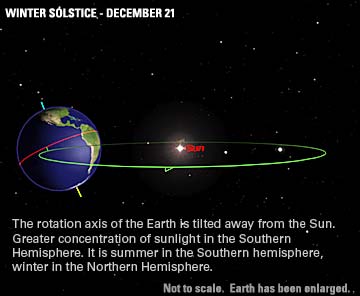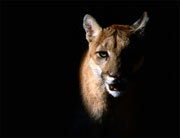Winter Solstice: Axial Tilt Is The Reason For The Season

 http://en.wikipedia.org/wiki/Solstice
http://en.wikipedia.org/wiki/Solstice
 Winter Festivals and the Solstice
Winter Festivals and the Solstice
Samanthasmom says: Greenconsciousness,For those of us who live in the northern hemisphere, the sun is actually at its closest point to us on the winter solstice and farthest away at summer solstice, and it’s the opposite in the southern hemisphere. I would love for children to become more in tune with the motion of our planet and its position in the universe. ( Happy Perihelion) Not only would it make them more knowledgeable, it would also foster some humility.
The Winter Solstice occurs exactly when the earth's axial tilt is farthest away from the sun at its maximum of 23° 26'. Though the Winter Solstice lasts an instant in time, the term is also colloquially used like Midwinter to refer to the day on which it occurs.At first glance, it makes no sense. If Earth is closest to the Sun in
January, shouldn’t it be summer? Maybe, if you live in the Southern
Hemisphere. So what does this mean?
Earth’s orbit is not a perfect circle. It is elliptical, or slightly oval-shaped. This means there is one point in the orbit where Earth is closest to the Sun, and another where Earth is farthest from the Sun. The closest point occurs in early January,
and the far point happens in early July (July 7, 2007). If this is the mechanism that causes seasons, it makes some sense for the Southern Hemisphere. But, as an explanation for the Northern Hemisphere, it fails miserably.
In fact, Earth’s elliptical orbit has nothing to do with seasons. The reason for seasons was explained in last month’s column, and it has to do with the tilt of Earth’s axis. But our non-circular orbit does have an observable effect. It produces, in concert with our tilted axis, the analemma.
For most people in the high latitudes this is commonly known as the shortest day and the sun's daily maximum position in the sky is the lowest.
The seasonal significance of the Winter Solstice is in the reversal of the gradual lengthening of nights and shortening of days.
The Winter Solstice is also the shortest day or lowest sun position for people in low latitudes located between the Tropic of Cancer (23°26'N) and the Tropic of Capricorn (23°26'S).[1]
Depending on the shift of the calendar, the winter solstice occurs some time between December 21 and December 22 each year in the Northern Hemisphere, and between June 20 and June 21 in the Southern Hemisphere.[2]
_________________________________________
SOLSTICE GREETING CARDS
____________________________________
http://www.greenconsciousness.org/weblog/2007/12/winter-solstice.html
http://www.greenconsciousness.org/winter_solstice.html
http://www.greenconsciousness.org/weblog/2008/12/happy-winter-solstice.html
http://www.greenconsciousness.org/weblog/2008/12/example-of-homemade-tree.html
http://www.greenconsciousness.org/weblog/2008/12/poem-to-earth.html
http://www.opb.org/programs/artbeat/segments/view/762
_______________________________________________________
The first day of Winter. THE MOMENT THE SUN REACHES ITS' GREATEST DISTANCE SOUTH OF THE EQUATOR. Following this, the sun begins to travel back toward the north. Amounts of sunlight which begin to decrease after each June's Summer Solstice now begin to increase all through the bitter cold which is the result of that decrease.
So that life is born in death and death is born in life.
And only change is constant. The lesson is to keep the faith even in the darkest time when all the doors are shut and life is hard, for your good times are slowly returning. Live to meet them.
http://www.witchvox.com/va/dt_va.html?a=usor&c=holidays&id=4955
http://housewrenstudio.typepad.com/charlotte/
http://www.candlegrove.com/mail.html#holly















































0 Comments:
Post a Comment